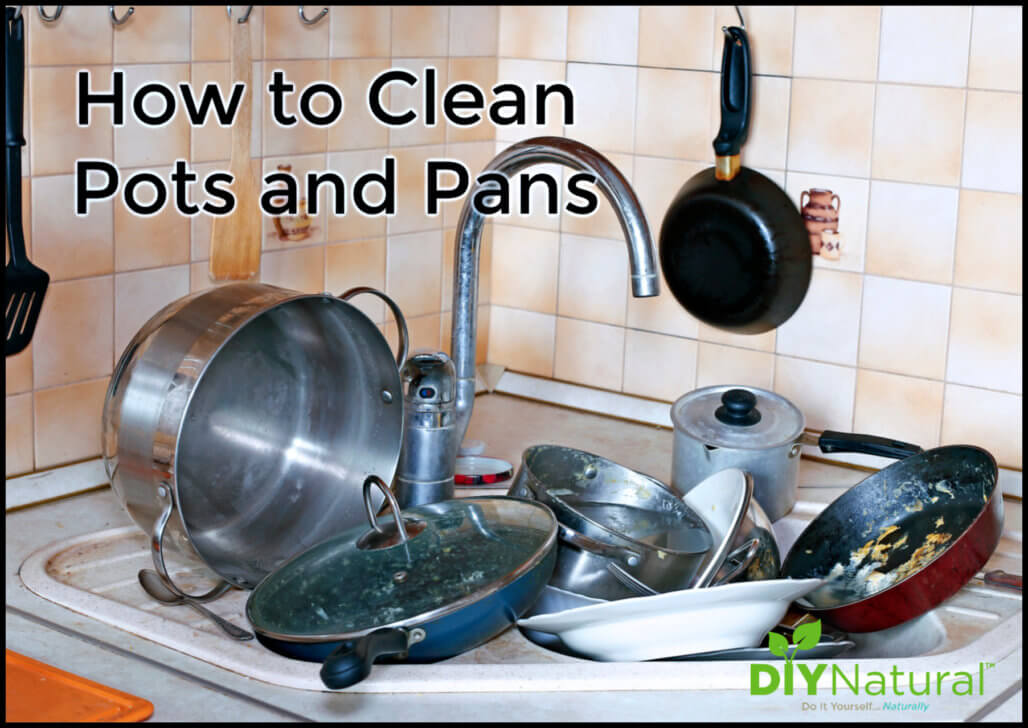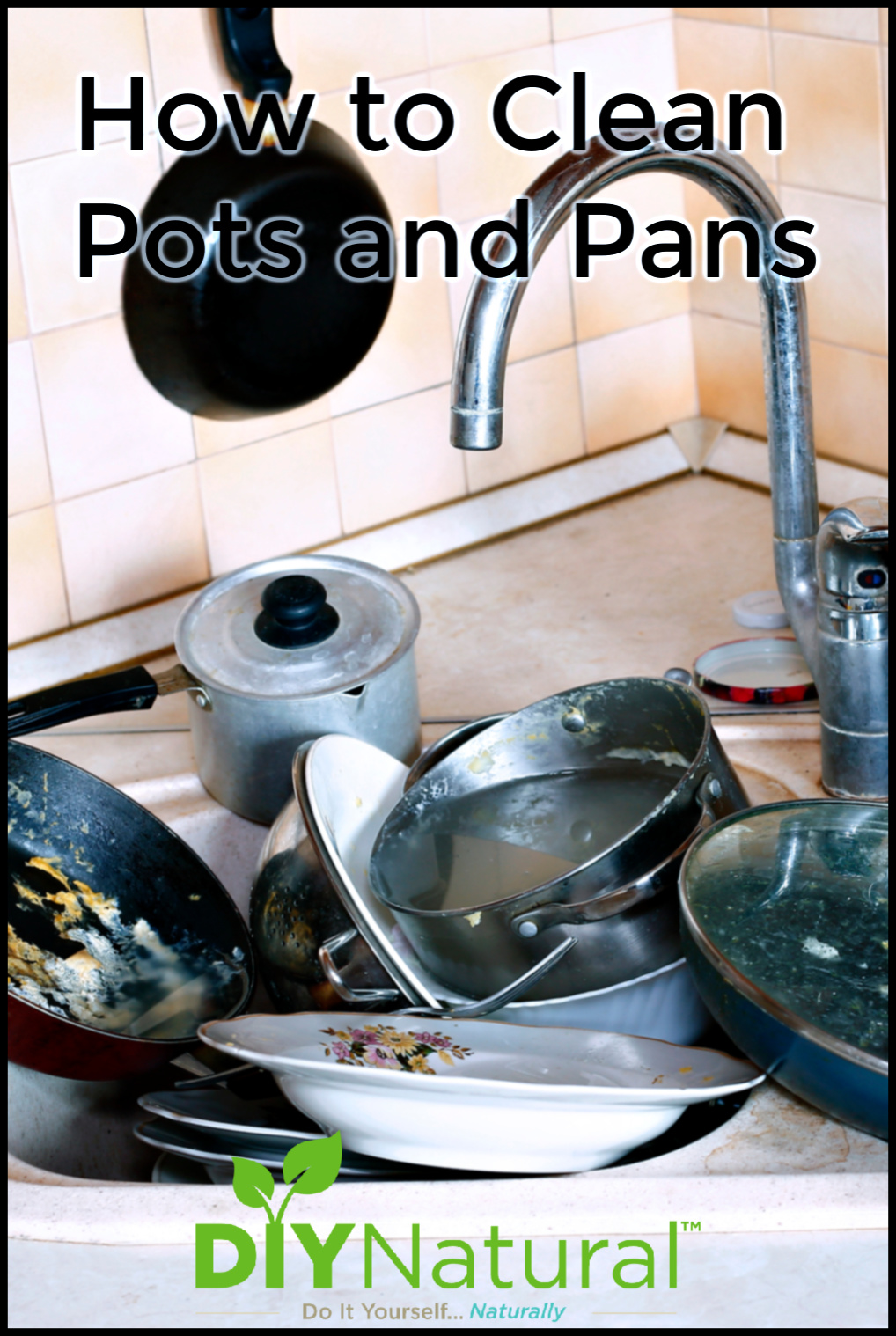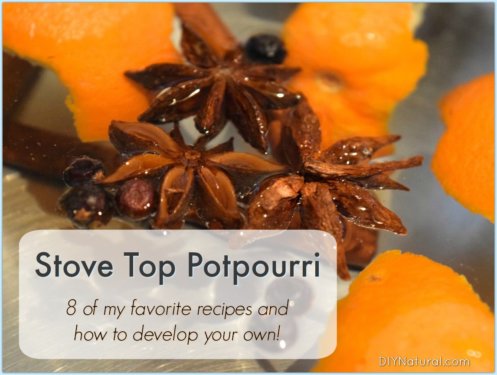
We should wash dishes right away. But raise your hand if you’ve ever let them sit. Yeah, us too. Now let’s learn how to clean pots and pans with build-up!
I have to admit that cleanliness is not my strongest suit. Given a choice, I’d rather be outside or making soap. But not washing the dishes right away, especially pots and pans, makes them SO much harder to clean. But we have all been guilty of this at some point so let’s talk about how to clean pots and pans with built-up gunk.
How to Clean Pots and Pans
Stainless steel and copper bottom pans will respond well to the following methods. However, they may damage non-stick pans on the inside so only use them to clean the outside of those pans.
Pre-Cleaning
Wash what you can off of the pan and allow it to dry. Sometimes just getting to the gunk is the hardest part. Once they are dry, you can go to the next step.
Methods for Cleaning Pots and Pans
Here are some great ways to clean your pots and pans. Some may seem strange at first, but give them a try! When you are done cleaning with these, you’ll want to wash your pan as you normally would.
Potato and Salt
Cut a potato in half and dip it in a fine grain salt. Rub this over the bottom of the pan and up onto the sides if necessary. Depending on how long the gunk has been on your pots and pans, you may need some elbow grease to get it to come off.
Lemon or Lime and Salt
This works the same way as with the potato, but the acid from the lemon or lime will help cut through any grease.
Vinegar and Citrus Peel
Take any citrus peels, like orange, and place them in a jar. Cover with cleaning vinegar. Cleaning vinegar is 6% acidity instead of the usual 5% and yes, it makes a difference. Place the cap on the jar and tighten well. Shake the mix and place in the sun for a few days. Strain and transfer to a spray bottle. Use this spray for cleaning your pots and pans. Spray well and let sit for 20-30 minutes. The gunk should just wipe right off. Again, depending on how long it’s been there, you may need to do it more than once.
Orange Essential Oil
Wet a cotton ball with orange essential oil and wipe onto the bad spots. Leave on 10 minutes or so, then wipe off. The orange essential oil contains a solvent called limonene that breaks down the gunk stuck on your pots and pans. It’s also great for cleaning up pine sap, like on your live Christmas tree.
Caution: orange essential oil is strong and could damage the color on painted pans.
Baking soda
Baking soda is a gentle abrasive like salt. Dip a damp dishcloth into some, rub gently to clean your pots and pans, and rinse off.
Steam
Sometimes you can get the gunk off with just steam. Hold the pan above boiling water and wipe off what you can.
Ketchup
If your pots and pans are tarnished as well as dirty, the fruit acids in ketchup can help! Spread a thick layer over the bottom of the pan and let sit for 20 minutes or so, you should be able to wipe the tarnish and gunk right off.
Diatomaceous Earth
Like baking soda, diatomaceous earth is a fine abrasive that will help clean the gunk off of your pots and pans. Use it the same way you would use baking soda. Avoid inhaling the fine crystals as they could irritate your nasal passages.
How NOT to Clean Your Pots and Pans
Abrasive Pads
Some of the things I’ve found that don’t work are sandpaper and abrasive pads. These get gummed up right away and just tend to spread the gunk around rather than removing it. If you want to try to use them, be prepared to toss them after you are done.
Soaking Greasy Pans
Soaking greasy pans for extended periods of time doesn’t work either. It can help sugar-based build-up but the gunk from grease won’t be affected by the water, no matter how hot it is.
An Ounce of Prevention is Worth a Pound of Cure
To prevent gunk from building up on your pots and pans in the first place, wash them thoroughly, inside and outside, and dry well. This is true with pots, pans, and pretty much every other type of dish. So just get it done ASAP. Work before play! Right?
Have you found a natural way to clean built-up gunk on your pots and pans? Tell us about it!
*******




I
Echo my vote for the stovetop-simmering method. Works EVERY. SINGLE. TIME, doesn’t require rinse-and-repeat, and is very quick on any kind of pan. And a wooden spatula ensures that there will be no damage.
Before I put the pot or pan on the stove, I use one of those little plastic kitchen scraper thingies to get the biggest bits of gunk off. After boiling and rinsing, and ideally, while the pan is still warm, if there are any bits of gunk still lingering, the scaper will take care of that too.
I agree that a traditional scouring pad (SOS, Brillo, etc.) is ALWAYS a no-no for any type of pot or cooking vessel or surface (including drip pans, stovetops, etc.) because they are way too abrasive and will ruin the finish and leave scratch marks. But for stainless steel, aluminum, Calphalon, ovens interiors, and glass, I like to use 0000 stainless steel pads for the final cleaning (after the majority of gunk is gone). I add a few drops of dish soap to the pad.
Not only does this remove any residue from baking soda or substances, as well as every little bit of stubborn gunk, it also leaves a wonderful shine, especially on stainless steel or porcelain, and doesn’t damage the surface.
I cut the pads in half or thirds when using them, because you usually only need a small amount (except perhaps for when cleaning the oven). After using, I rinse all the soap and gunk out, squeeze out the excess water, fold it into a small piece of tinfoil, and store it in the freezer. A single pad last me for months that way, with no rusting.
I also really love using the 0000 pads for a weekly deep-cleaning of my stainless steel sink. I use it with lemon essential oil, critic acid, and a small amount of dish soap. After cleaning, I buff the sink with a small amount of coconut oil (any oil will do, but this is my preference) and lemon essential oil. I wipe it dry after each use with a special microfiber cloth inside my under-sink door that’s just for my sink, and with this routine, it stays super-shiny all week long. I think the 0000 pad is a key component in getting every last bit of gunk and residue off the sink during the weekly deep-cleaning routine and helping to keep it shiny and smooth to the touch all week long.
If a something in a pan has gotten burnt on, I put about a half inch of water in it and sprinkle a generous amount of baking soda on the burnt gook. Simmer on the stove and the burnt stuff will lift off with a wooden spatula.
I’ve found the best and fastest way to clean a grimy, gunked up pot is to fill it about 3/4 full of water, add a squirt of dish soap and boil it. There’s almost no scrubbing involved. Hope this helps someone and thanks for all of the instructions throughout the years.